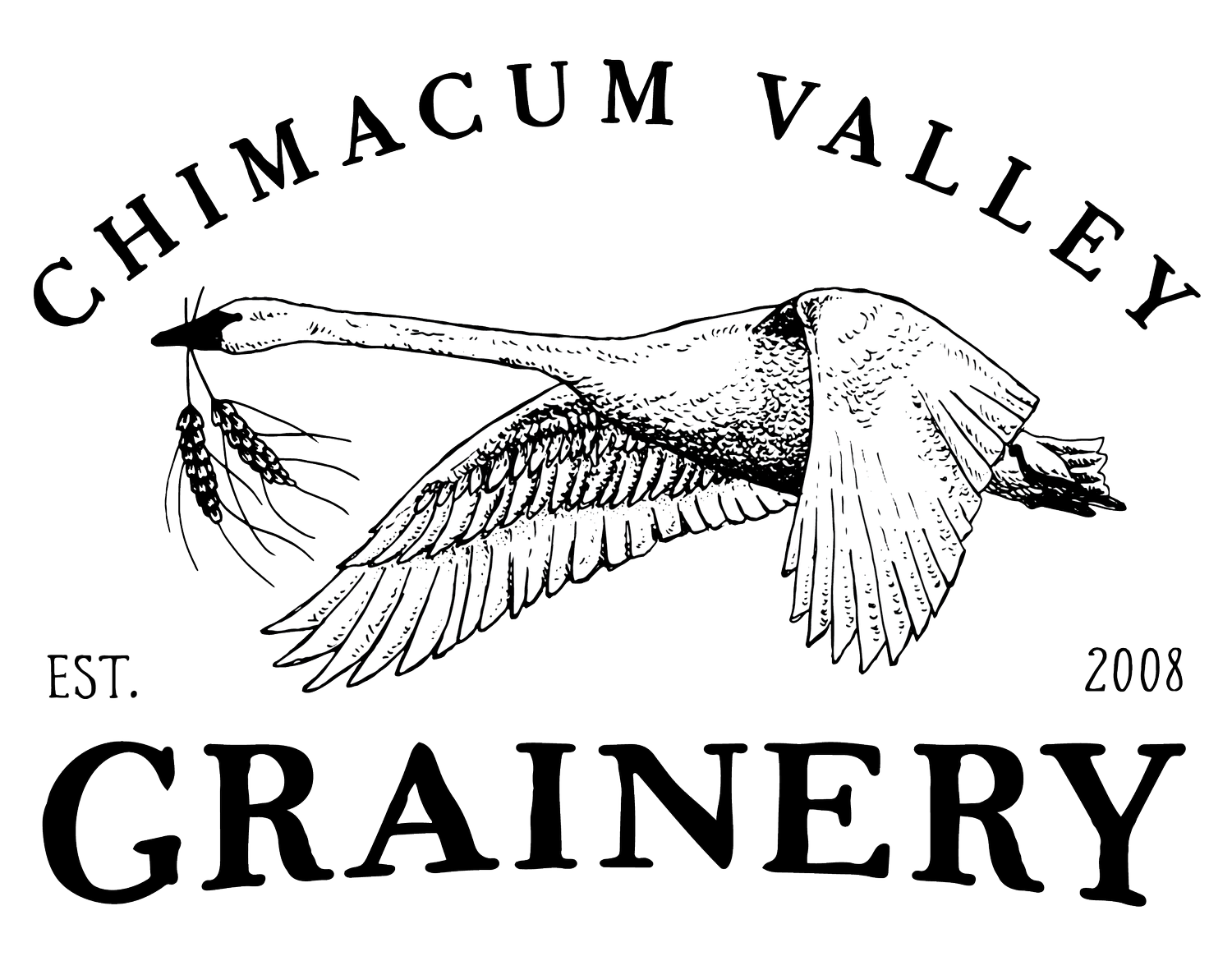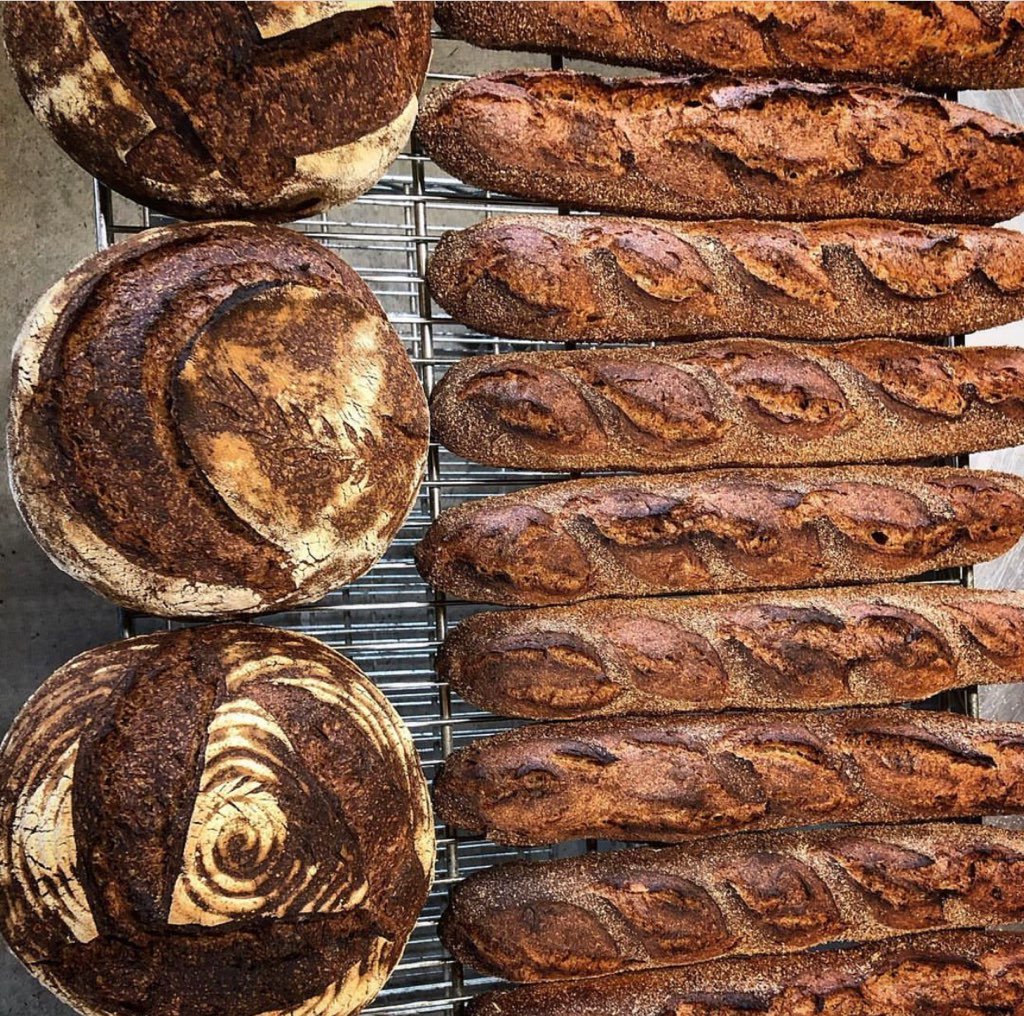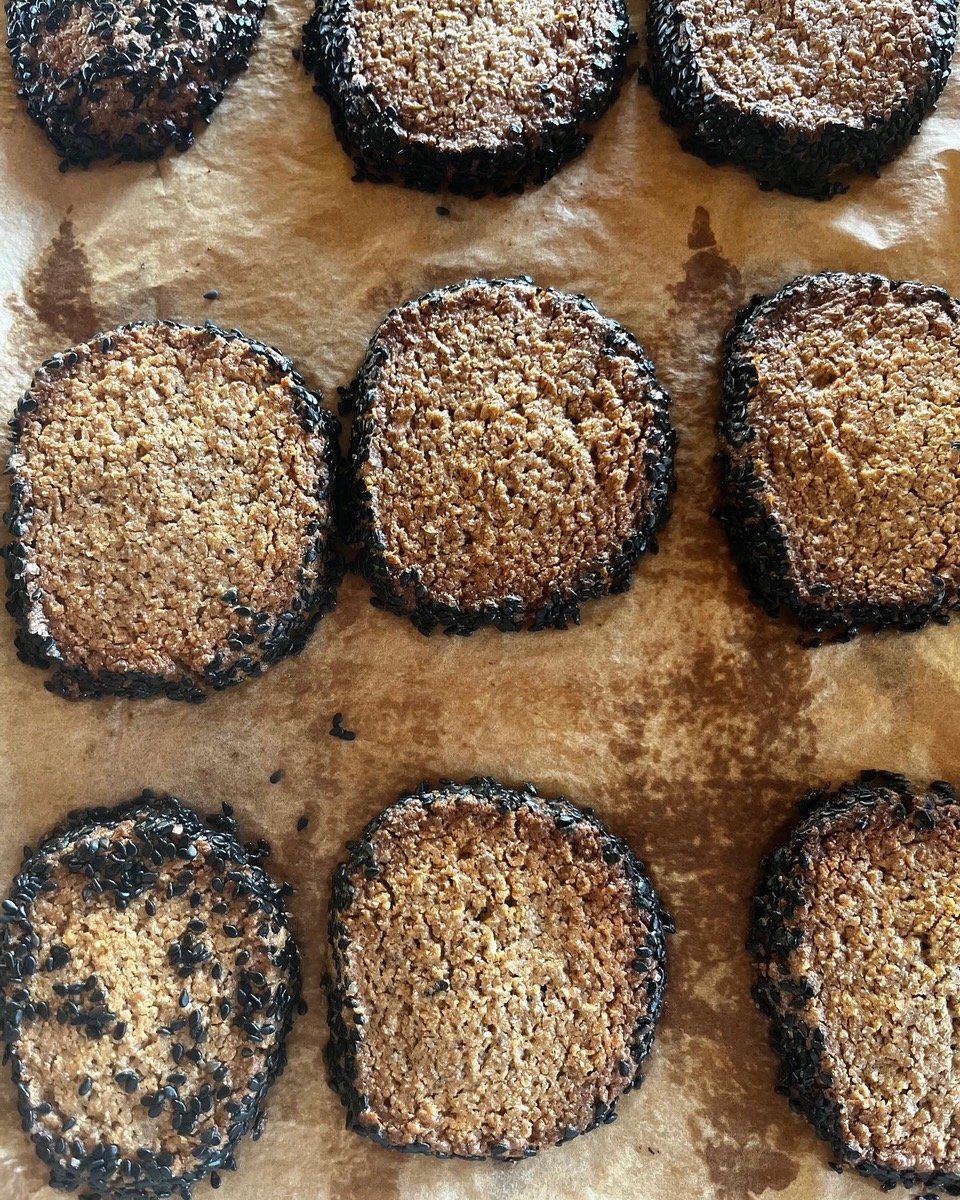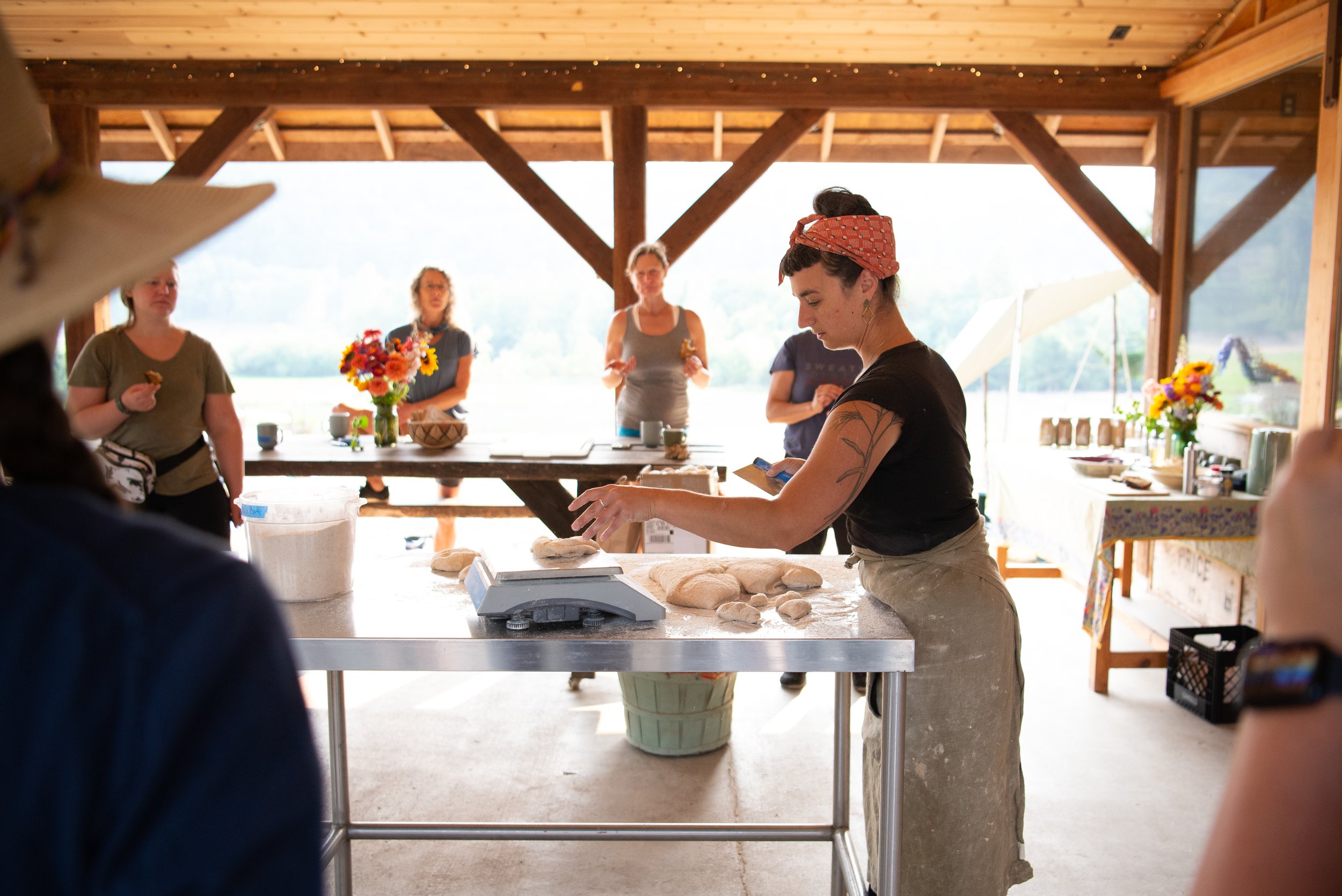"A wheat seed is a perfect package. Like a spaceship, with everything needed to sustain life."
-Micheal Pollan

BAYLIN’S
Baking tips
For millennia people have been putting water to grain to feed themselves. Taking earth and water and mixing them together – it is with this simple alchemy that we can create something life sustaining, something delicious.
I came into the baking industry using primarily commodity flour. Silky and starched white – a result of highly extractive milling, bromating, bleaching and other chemical processes. Using whole grains can be a huge shock to someone who has gotten used to baking with ultra sifted, commodity high protein bread flour. Think of white flour as the 'fast food' of the flour industry.
When I came here to the Chimacum Valley Grainery, I knew they were doing something really special. Baking with whole organic grains grown hyper-locally was a whole new practice to dive into. I knew I was going to need to reinvent how I saw bread baking and mostly how I saw water and the role it plays in the process.
Water
One of the key ingredients to success when baking with whole grains is water. Think of water as a softener, or a lubricant for the activity you will create in your mixes. Stone-milled whole grain is thirsty.
Once that wheat berry hits the mill stones, the bran gets cracked and is made sharp. These sharp peices of bran can act like razor blades, cutting straight through your gluten network. Adding a sufficient amount of water during your mixing process can help hydrate the bran, softening it's edges and unlocking more of its nutrient potential.
When we extract the bran and the germ from a wheat kernel through the sifting process, we are also extracting a lot of its nutrients. The bran holds so much of the protein, vitamins and minerals we need in our diet. Water is the main way we can help our bodies harness these nutrients and use them for fuel.
When we mix water and flour, the activation of enzymes begin. It wakes up yeasts to start turning sugars into gas, and proteins into a flexible network to trap that gas, which is what rises your bread.
Wetter is better, to a point. However, if you're just starting out baking, start with a lower hydration. A stiffer dough can be easier for beginners to handle with out getting too frustrated with sticky dough and messy hands. Hydration at 75% is a great beginning place and a fine hydration for making baguettes, and some yeast loaves for sandwich bread.
As you become more comfortable with handling dough, up your hydration to 80, 85, or 90% when transitioning to primarily whole grain baking. Using water to help shape your bread, instead of flour, can also help keep things smooth and lubricated.
Autolyse
Autolysing is a technique many bakers use to aid the absorption of water into their flour. There are a couple different ways bakers like to use this technique.
A traditional autolyse is mixing the flour and water called for in your recipe together to a rough mix-- mixed until a shaggy dough forms. Allow this mixture to sit for a period of time (anywhere from 1-4 hours) before adding your levain and your salt. Salt is hygroscopic and pulls hydration away from the flour. We want to give our flour all the chance it has to become hydrated and soften those sharp bran pieces.
This is especially helpful in a high hydrated dough. When your autolyse period is over you will notice a strength and elasticity begins to form in your dough with just the water and flour sitting together in a bowl.
Fermentolyse
Much like an autolyse, however this technique includes your levain with the first initial rough mix. Salt is added later for the same reason of allowing water absorption. Adding the levain early in this stage helps with bulk times and begin the fermentation process.
time
ANow that we've talked about the importance of water in our mixing let's think about time. Time is as important an ingredient as the flour we use. Give your loaf the time it needs to increase in volume and build a sufficient amount of gas to stretch the network you've created via your mixing process. Giving your dough a consistent series of stretch and folds as it rises in bulk form will help create a lofty loaf when it's ready to shape and bake.
Do not rush your bread, if you are feeling like you won't be able to give it stretches and folds every hour during it's bulk time stick it in the fridge to slow down the fermentation process. When the summer months hit this can be a life savor so your dough doesn't move too quickly.
temperature
There are ways to help coax your dough along that can be helpful especially in the colder months when our levain is sleepy, and our homes are a little more consistently chilly.
Using warmer water can help move along fermentation. Placing your dough in an oven with only the light on just to keep it warm enough to rise.
Levain, a.k.a. Sourdough Culture
Seed: a small portion of culture used to build a larger portion of starter
Starter: the final product of mixing seed, water and flour
Levain: the mature starter used in a bread formula
One of the key foundations to a beautiful loaf of bread is levain health.
Ensuring your levain is at its peak when you add it to your mix can effect the process as a whole. Keeping your starter on a consistent regular feeding schedule is always the best, however who has the time to bake every other day!
Again, utilizing temperature, we can slow down the fermentation process and keep a sourdough culture maturing slowly or even arrest its fermentation rate for a time, and use it when it best fits our schedule. Storing it in the refrigerator is a great help when we need to get the jar off the counter, and out of sight for a few weeks.
Sourdough starter is so much more hardy than people think! I've had starters sitting in the back of my fridge, unfed for weeks that perk right up after a refresher feed. A lot of folks think that once the hooch forms on top they need to pitch the entire starter, but that alcohol is just a sign that the yeasts are hungry and want a feeding. You can pour it off the top and resume a standard feeding, and the culture will spring back to life.
Before mixing your levain into your bread however, you do want to be certain that your levain is strong and healthy.
The night before you want to mix, pull your starter out of the fridge and give it a feed. Let it sit on the counter and mature, and it should be ready for a bread mix in the morning. There are many signs to look for when checking if your levain is ready to use:
Pay attention to smell, the levain should have a sour, vinegary scent.
Its texture should be lacy and bubbles should be obvious and visible through the jar.
It should be larger in volume. Mark your starter jar with a piece of tape, or a rubber band to track it's growth.
Another way to check if it's ready is a float test. Take a small portion of your levain and drop it into a glass of water, if it floats, it's filled with gas and ready to use. This test is usually a great indicator, although I've had some levain sink and still make beautiful bread. It's best to use all your senses in knowing when to use your levain.
Keeping your ratios of seed to water to flour in balance can go a long way in the health and maturation of your levain.Sourdough culture is a living thing, and just like all living things it needs fuel to survive.
A .5:1:1 (.5 part seed,1 part water, 1 part flour) ratio has always proven a success for me when I'm in a regular baking schedule. Leaving my starter out on the counter to mature when I'm baking everyday, or in the fridge if i'm only baking once or twice a week.
Senses & Intuition
So much of baking for me goes beyond the formulas and carefully calculated and measured ingredients. So much of baking is intuition and relying on your senses to indicate if something is ready. Touch, smell, sight-- these will all help you know when dough is ready to fold, ready to shape, ready to bake.
The best advise anyone could get for trying new things is practice, practice, practice. The more you try one recipe, the more you start to understand the small nuances of a formula.

- Baylin, Grainery baker, on IG at @dustedstone
Keep on baking!
Once a week is great!
Twice a week is even better!
Just like bread, the only way we get better is with time.





